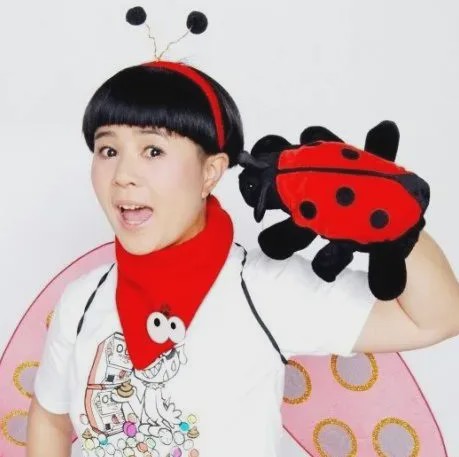When I was a child, I watched a children's channel with a scarab sister.

I always thought that the scarab beetle was the little bug that my sister was holding in her hand, but I thought it looked more like a seven-star ladybug.
Let's sort out this relationship.
Scarab beetles are small insects of the order Coleoptera, about 30,000 species, and there are 1300 species in China.
The larvae of the scarab beetle are also called grubs, commonly known as earth silkworms, silkworms, and ground dogs, about 3-4 cm long, white in color, yellowish brown in head, hard in mouth, often bent into horseshoes, and during their infancy, they are small insects that roll flesh and will nibble on the rhizomes of plants.
Adult worms are called chestnut worms, yellow worms, blind bulbs (Lunan), the body is oval, or oval, antennae gill leaf-like, composed of 9 to 11 segments, each section can open and close freely. Adults will nibble on the leaves, and in severe cases, they will nibble on the plant and only the main vein remains.
Two species of scarab beetles are introduced below, one larvae overwintering and one adult overwintering.
Patina scarab
Eggs: long ovate, milky white.
Larvae: milky white, brown head, curved body, enlarged ventral end, with three pairs of pectoral feet, gastropod degeneration, called grub.
Pupae: yellow-brown, naked pupae.
Adult: Body length of about 19 mm, oblong oval. The elytra are copper-green, shiny, and covered with regular dot grooves. The thorax is patina with yellow trims on both sides.
Breeding begins in August, and in ten days the larvae hatch and the larvae eat the roots of the plant.
The larvae overwinter in the soil, pupate in May of the following year, and the adults appear in early June, with strong phototropism, diurnal and nocturnal outcrops, lurking under the cover of weeds and bushes during the day, gathering in the evening to eat the leaves on the canopy, and in severe cases the leaves of the whole tree are eaten until only the veins and petioles remain.
Black velvet scarab beetle
Eggs: Oval, initially milky white, followed by off-white. Glossy
Pupae: yellow-brown or black-brown,
Larvae: yellow-brown head, curved body, dirty white, yellow-brown bristles on the body, three pairs of pectoral feet, and the longest hind feet.
Adult: 6-9 mm long, 3-5 mm wide, ovoid, narrow front and wide, black or black brown, velvety gloss on the surface of the body.
One generation a year, breeding begins in late June, pupates in August, feathers into the ground after the adults spend the winter, april began to emerge activities, black velvet scarab beetle adult period is longer.
---------♥---------
Unlike scarab beetles, the seven-star ladybird is a beneficial insect, the seven-star ladybird is oval, water-ladybird-shaped, and the elytra are red, but there are three black dots on each side, and one dot is in the center of the two elytra wings, for a total of seven black dots.
The ecological distribution of the seven-star ladybird is very wide, and they are found almost where there are aphids, and they are often used as biological control to control aphids.
Ladybirds rarely colonize, adults overwinter, and adult larvae eat aphids.
An aphid is a pest that sucks sap, shrinks, curls, deforms, and, in severe cases, causes wilting of branches and leaves or even the death of the whole plant.
When the yellow broccoli blooms, it is very attractive to aphids.
It can be simply understood that ladybugs are rounder than scarab beetles, and there are a little dots on the back.
Among the ladybugs, there are not only seven-star ladybirds and other ladybugs, some are beneficial insects and some are pests.
Beneficial insects are pest-eating (carnivorous), and pests are plant-eating (plant-eating). Another is to eat both – some ladybugs eat the hyphae and spores (i.e., fungal feeding) of powdery mildew.
There are about 4,000 species of ladybugs, and there are usually two, six, seven, eleven, thirteen, and twenty-eight black spots on the back.
Among them, the ladybug with twenty-eight black spots on its back is plant-eating, which is what we call a pest.
Or look at whether their hard wings are smooth to distinguish them, the hard wings are delicate and glowing with beneficial insects, and the hard wings with fine hairs are pests.
Let's show you some beautiful ladybugs.
The most impressive thing I remembered was the two ladybugs in Luo Xiaohei, who appeared a lot, and each appearance was two in xxoo.
- End -
Author: Zhang Yuelu; Article from: Xinci Climbing Boundary; Follow me to take you to learn more about animal knowledge.